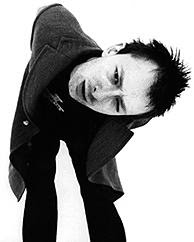SHAUN OF THE DEAD (2004)
On-set make-up design at Ealing Studios.
THE flesh-eating zombie film, essentially invented by George A. Romero in NIGHT OF THE LIVING DEAD, has thrown off parodies, rip-offs and tangents for nearly four decades. Coincidentally released at the same time as the Hollywood remake of Romero’s DAWN OF THE DEAD, SHAUN OF THE DEAD offers an exuberantly knowing take on the Pittsburgh director, extending Romero’s state-of-the-nation addresses by translating an apparently American sub-genre into a uniquely British canvas of dead-end jobs and uncongenial flat-shares. A self-styled "romantic comedy, with zombies," it features 29-year-old Londoner Shaun (Simon Pegg), whose lack of ambition, and camaraderie with slacker pal Ed (Nick Frost), continually distracts him from his responsibilities to his mother Barbara (Penelope Wilson) and girlfriend Liz (Kate Ashfield). When Liz dumps him, Shaun finally resolves to "sort his life out," at the same time that the population are turning into ghouls. SHAUN OF THE DEAD’s anti-zombie arsenal remains resolutely English – cricket bats, umbrellas, darts and hockey sticks – with the final siege uprooting Romero’s shopping mall to The Winchester Public House.
Co-written by Pegg and director Edgar Wright, SHAUN OF THE DEAD understands that when the zombie genre works, it is on the grounds of satire and trenchant sociology. One of the endearing aspects of the film is that, similar to YOUNG FRANKENSTEIN, it pokes fun at its inspirations but also plays by their rules. An obvious way of parodying this sub-genre is to make the creatures comical, but the dead here are bloody-mouthed fumblers, with the laughs coming at the expense of the living. Consequently, the film delivers the visceral shocks, but we are also allowed to get to know the characters before the undead takes hold. In its final third the story shifts into a much darker mode - having listened to a moving valedictory speech from his steadily zombifying stepfather (Bill Nighy), Shaun is later required to kill his own mother.
Ed and Shaun face the first true test of their lives – a plague of zombies.
Shaun is an instantly loveable anti-hero, in no way motivated by aspersions of heroism, but prevailing by the strength of his previously untapped inner-strength. Pegg’s impeccable performance fuses subtle comedic tics, crack timing and committed emotional reality, while Frost unleashes a hilarious stream of practical jokery and an incompetence which is as endearing as it is stupid. Inspired by a TV skit from their own sitcom SPACED, Wright and Pegg embrace the snappiness of quality television comedy, forging a rapid cohesion of gags that push the narrative forward in decisive portions, while able to fluctuate swiftly between tone.




